Veterinary Telehealth Market Size
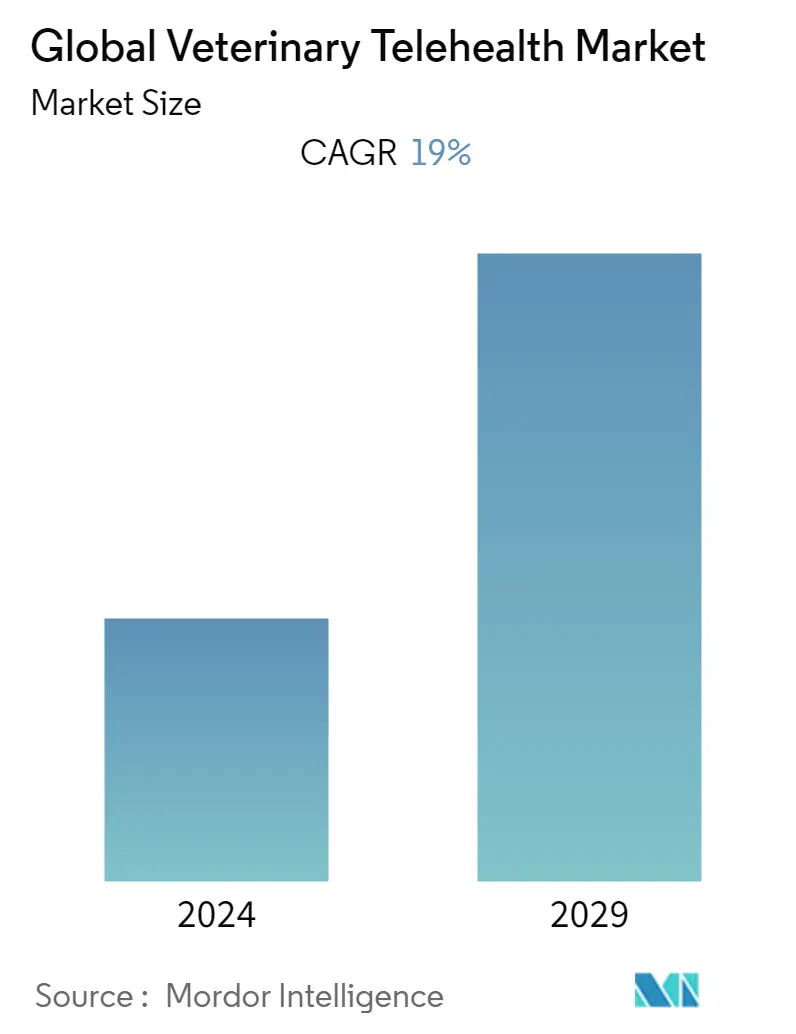
| Study Period | 2019 - 2029 |
| Base Year For Estimation | 2023 |
| CAGR | 19.00 % |
| Fastest Growing Market | Asia-Pacific |
| Largest Market | North America |
| Market Concentration | High |
Major Players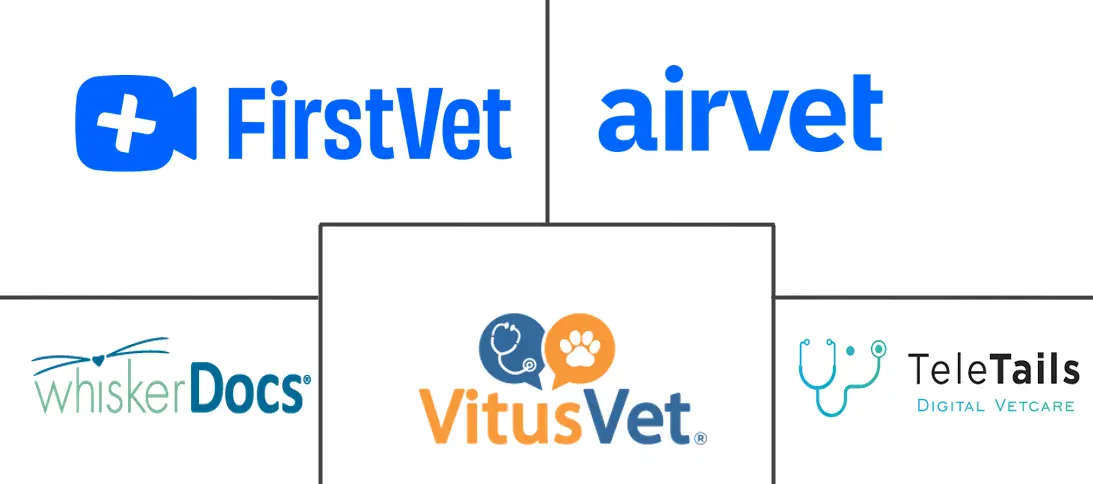
*Disclaimer: Major Players sorted in no particular order |
Veterinary Telehealth Market Analysis
The veterinary telehealth market is projected to register a CAGR of 19% during the forecast period (2022-2027).
The COVID-19 pandemic has significantly influenced the veterinary telehealth market. The interest in veterinary telehealth is increasing during the ongoing crisis. Several research showed that use of telemedicine has grown to protect and monitor the health of veterinary patients and veterinary teams. Additionally, the United States Food and Drug Administration (US FDA) was providing flexibility across FDA-regulated industries and announced that it does not intend to enforce certain requirements that may enable veterinarians to better utilize telemedicine to address animal health needs during the pandemic. Moreover, several healthcare organizations have also launched telehealth services. For instance, in March 2021, a leading integrated healthcare company in India, Practo, announced the launch of a veterinary telemedicine service. Thus, the factors mentioned above are leading to an increase in the number of veterinary telehealth services during the ongoing pandemic. Therefore, the pandemic is anticipated to have a significant impact on the market studied.
The growth of the market studied can be largely attributed to increasing pet ownership globally, an increase in pet healthcare spending, and the growing prevalence of zoonotic diseases. These factors are contributing to the increasing adoption of veterinary telehealth services.
Increasing pet ownership worldwide is contributing to the increasing adoption of telehealth services by pet owners. For instance, there has been an increase in pet adoption amid COVID-19, and this increase has occurred across all pet types, especially cats. As per the Canadian Animal Health Institute (CAHI), 2021 survey stats, cats continue to outnumber dogs in Canada, with 8.1 million cats considered to be household pets in the previous year. In addition, Interzoo Exhibition Centre data updated in April 2021 shows that, in total, Germans lived with 34.9 million dogs, cats, small mammals, and pet birds, and this number is almost 1 million more than in the prior years, and as per the source above, 66% of all families with children had a pet, and 13% of all households had at least two types of pets. Thus, increasing pet ownership worldwide is contributing to the rising demand for veterinary telehealth services.
Increasing pet healthcare spending across the globe will boost the demand for veterinary telehealth services. The growing concern of owners for their pets is leading to a huge expense made on veterinary care, such as routine veterinary care, medications, pet treats and food, grooming, insurance, training, pet sitting, and other services, which have surged the adoption of veterinary telehealth services. For instance, the statistics updated by the American Pet Products Association (APPA) show that the United States spent nearly USD 109.6 billion on pets in 2021. Additionally, as per the 'Expenditure Profile 2022-2023' published by the government of India, the Department of Animal Husbandry and Dairying has estimated a budget of USD 39,188 million to invest in the protection and preservation of livestock (Cattle, Sheep, and Poultry) through the provision of health care. Thus, the huge spending on veterinary healthcare indicates an increased usage of veterinary telehealth services.
Moreover, a significant rise in zoonotic diseases such as the prevalence of flea and tick-borne diseases in pet animals has been observed in recent years worldwide. Any pet with access to the outdoors is proved to be exposed to ticks. For instance, Moreover, the research article 'Flea and tick treatment satisfaction, preference, and adherence reported by cat owners in the United States, United Kingdom or France who treated their cats with transdermal fluralaner' published in July 2021, mentioned that a 28.1% prevalence of flea infestation in cats were found in the United Kingdom which is significantly higher than the 14.4% prevalence in dogs. As, telemedicine for pets allows pet parents to reach the veterinarian remotely for examinations, diagnosis, and treatment planning, such an increase in the diseases among companion animals is expected to create demand for veterinary telemedicine, driving the market growth over the forecast period.
However, high costs associated with the services and lack of awareness and accessibility to telehealth services in developing countries are some of the factors hindering the veterinary telehealth market growth.
Veterinary Telehealth Market Trends
This section covers the major market trends shaping the Veterinary Telehealth Market according to our research experts:
Telemedicine Segment is Expected to Witness a Significant Growth Over the Forecast Period
The telemedicine segment is anticipated to grow significantly owing to the increased internet penetration. Telemedicine is a technology that allows a veterinarian to digitalize radiographically, ultrasound, and microscopic images and send them via fax or the internet to a veterinary specialist for the interpretation providing service without leaving their veterinary hospital. The upsurge in the number of internet users is leading to wider adoption of veterinary telemedicine services.
Several market players are also engaged in launching veterinary telemedicine service platforms. For instance, Whiskers Worldwide LLC, one of the pet telehealth providers in North America, launched its proprietary telemedicine service for pet owners in the United States in January 2021. In addition, in February 2022, the Virtual veterinarian care platform Dutch raised USD 20 million in Series A funding led by Forerunner Ventures and Eclipse Ventures. The San Francisco-based company's latest round came seven months after its market launch bringing its total funding raised to USD 25 million. Dutch utilizes licensed veterinarians and provides telemedicine and a digital health platform for pets and their families to make pet care more accessible. Such development is anticipated to drive segment growth over the forecast period.
Moreover, several service providers are adopting and implementing telemedicine into their services. This is another factor fuelling the segment to grow. For instance, in July 2022, Dr. Treat: Tech-enabled veterinary care for highly personalized in-clinic and virtual care, building the next generation pet health company to deliver very personalized care to every pet all while creating a seamless, stress-free customer experience with its proprietary Telehealth & Telemedicine platform for 24/7 virtual care, integrated into Dr. Treat's app for all health needs of pets. Thus, such product launches and the adoption of telemedicine are expected to drive segment growth significantly over the forecast period.
Therefore, the above-mentioned factors attribute to the growth of the segment over the forecast period.
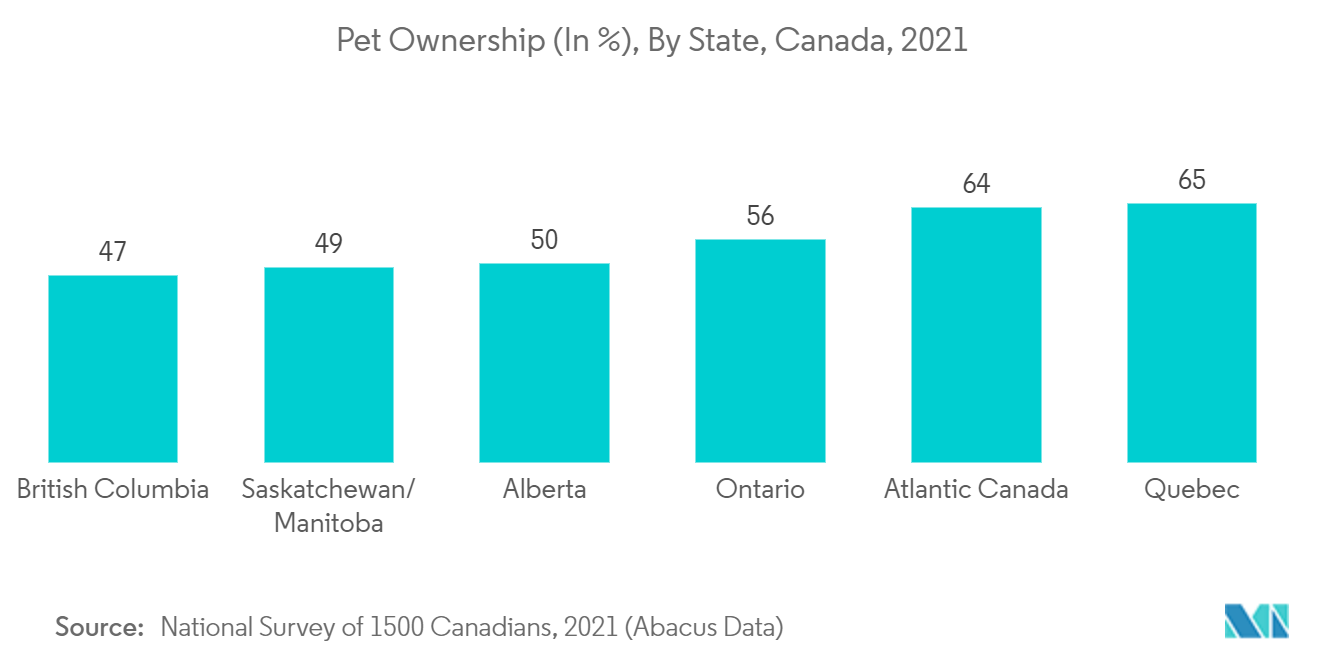
North America is Anticipated to Observe a Significant Growth in the Global Veterinary Telehealth Market
North America is likely to witness a high growth rate in the veterinary telehealth market during the forecast period. Within North America, the United States has held a significant share of the market, and it is expected to dominate over the forecast period. This can be attributed to the factors such as high healthcare expenditure, the strong presence of major market players, technological advancements, and an increase in disposable income.
Additionally, the preference for the adoption of pets owing to the need for companionship and lifestyle in the region has urged people in the United States to opt for pet insurance, thereby fuelling the utilization of veterinary telehealth services. For instance, a survey conducted by the American Pet Products Association (APPA) in June 2021 shows that pet ownership has increased from an estimated 67% of United States households to an estimated 70%. During the pandemic, 14% of total pet owners and non-pet owners obtained a new pet. In developed countries like the United States and Canada, the escalation of pet approval, improving awareness about animal health, and increase in animal health expenses are the drivers to boost the growth of the veterinary telehealth market.
Moreover, the increase in consumption of livestock products is contributing to the high demand for veterinary healthcare in the region, thereby, further fuelling the demand for veterinary telehealth services. For instance, as per the United States Department of Agriculture 'National Agricultural Statistics Service-2021', the number of cattle and calves in the United States is 93 million approximately. In addition, continuous developments in the country are also another major factor driving the market growth in the region. Such as, in August 2021, Vetster.com, one of the world's fastest-growing veterinary telehealth and pet care marketplace, launched VetsterRx Online Pharmacy, the first online pet pharmacy provided by a veterinary telehealth platform. The delivery service for pet medications is currently available to Vetster customers in the United States through the company's new mobile app and at Vetster.com. Thus, given the factors mentioned, the veterinary telehealth market in North America is anticipated to grow significantly over the forecast period.
Therefore, owing to the aforesaid factors the market is anticipated to witness growth in the region over the forecast period.
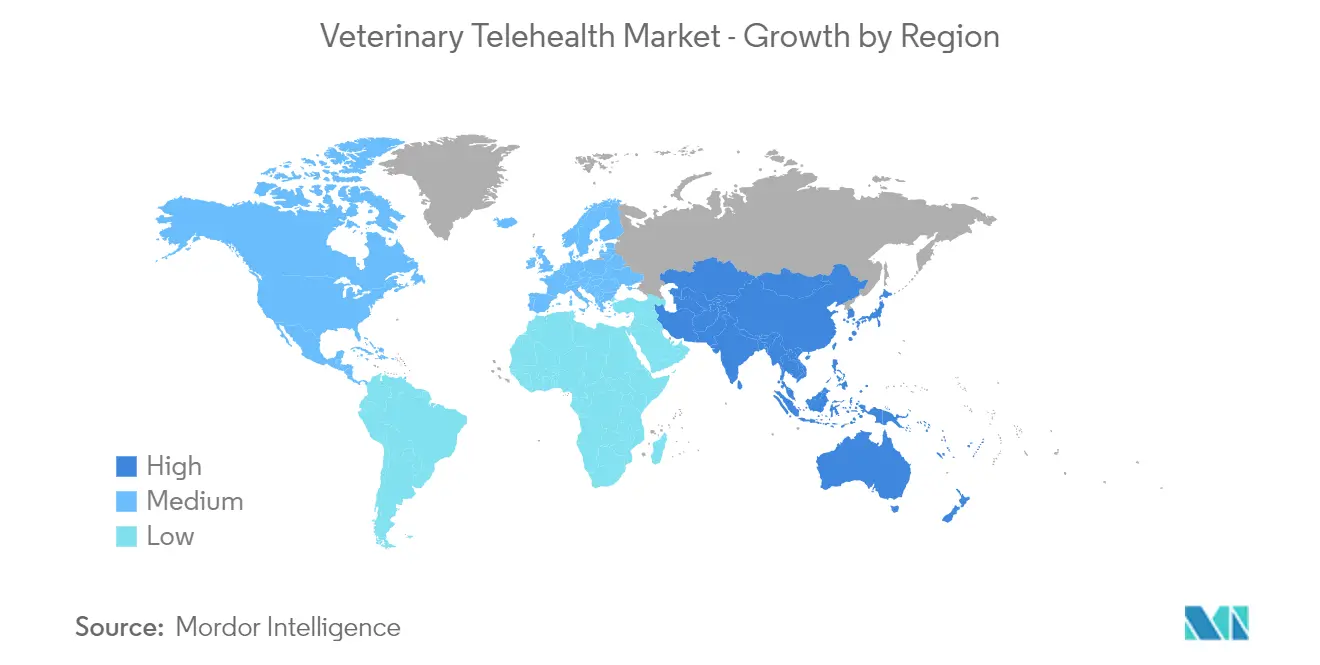
Veterinary Telehealth Industry Overview
The veterinary telehealth market is competitive, with the presence of many local and international players. Key players are adopting different growth strategies to enhance their market presence, such as partnerships, agreements, collaborations, new product launches, geographical expansions, mergers, and acquisitions. Some of the key players in the market are TeleTails, FirstVet, Whiskers Worldwide LLC, VitusVet, and Airvet.
Veterinary Telehealth Market Leaders
-
Airvet
-
TeleTails
-
FirstVet
-
VitusVet
-
Whiskers Worldwide, LLC
*Disclaimer: Major Players sorted in no particular order
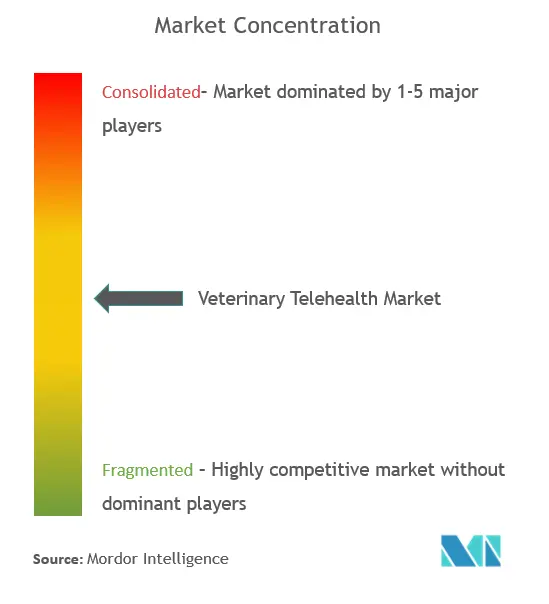
Veterinary Telehealth Market News
- In May 2022, Bonum Health, a Digital Healthcare business subsidiary of TRxADE HEALTH, INC. an integrated drug procurement, delivery, and healthcare platform, launched Tele-Veterinary services for pets.
- In May 2022, Penn Foster, one of the talent development platforms launched a new certification program designed to help veterinary professionals build critical telehealth skills. The curriculum, which is the first-ever accredited training program specifically tailored for remote pet care, will enable current veterinary technicians, assistants, and administrators, to provide cutting-edge virtual care to their patients, and support veterinary teams as they respond to the pandemic-induced increase in pet ownership.
Veterinary Telehealth Market Report - Table of Contents
1. INTRODUCTION
- 1.1 Study Assumptions and Market Definition
- 1.2 Scope of the Study
2. RESEARCH METHODOLOGY
3. EXECUTIVE SUMMARY
4. MARKET DYNAMICS
- 4.1 Market Overview
-
4.2 Market Drivers
- 4.2.1 Increasing Pet Ownership Across the Globe
- 4.2.2 Increase in Veterinary Healthcare Spending
- 4.2.3 Growing Prevalence of Zoonotic Diseases
-
4.3 Market Restraints
- 4.3.1 High Cost Associated with the Services
- 4.3.2 Lack of Awareness and Accessbility to Telehealth Services in Developing Countries
-
4.4 Industry Attractiveness - Porter's Five Forces Analysis
- 4.4.1 Bargaining Power of Buyers/Consumers
- 4.4.2 Bargaining Power of Suppliers
- 4.4.3 Threat of New Entrants
- 4.4.4 Threat of Substitute Products
- 4.4.5 Intensity of Competitive Rivalry
5. MARKET SEGMENTATION (Market Size by Value - USD million)
-
5.1 By Animal
- 5.1.1 Companion Animal
- 5.1.1.1 Cats
- 5.1.1.2 Dogs
- 5.1.1.3 Horses
- 5.1.1.4 Other Pet Animals
- 5.1.2 Livestock Animal
- 5.1.2.1 Cattle
- 5.1.2.2 Sheep
- 5.1.2.3 Poultry
- 5.1.2.4 Other Animals
-
5.2 By Service Type
- 5.2.1 Telemedicine
- 5.2.2 Teleconsulting
- 5.2.3 Telemonitoring
- 5.2.4 Other Service Types
-
5.3 By Geography
- 5.3.1 North America
- 5.3.1.1 United States
- 5.3.1.2 Canada
- 5.3.1.3 Mexico
- 5.3.2 Europe
- 5.3.2.1 Germany
- 5.3.2.2 United Kingdom
- 5.3.2.3 France
- 5.3.2.4 Italy
- 5.3.2.5 Spain
- 5.3.2.6 Rest of Europe
- 5.3.3 Asia Pacific
- 5.3.3.1 China
- 5.3.3.2 Japan
- 5.3.3.3 India
- 5.3.3.4 Australia
- 5.3.3.5 South Korea
- 5.3.3.6 Rest of Asia Pacific
- 5.3.4 Rest of the World
6. COMPETITIVE LANDSCAPE
-
6.1 Company Profiles
- 6.1.1 Airvet
- 6.1.2 GuardianVets
- 6.1.3 TeleVet
- 6.1.4 TeleTails
- 6.1.5 VitusVet
- 6.1.6 FirstVet
- 6.1.7 PetDesk
- 6.1.8 Whiskers Worldwide LLC
- 6.1.9 Virtuwoof LLC
- 6.1.10 Petriage Inc.
- 6.1.11 Petzam
- 6.1.12 Animan Technologies Inc.
- *List Not Exhaustive
7. MARKET OPPORTUNITIES AND FUTURE TRENDS
** Subject To AvailablityVeterinary Telehealth Industry Segmentation
As per the scope of the report, veterinary telehealth is a service that facilitates medical advice through the internet to pet owners and to the people involved in the animal business. It is a way of delivering veterinary medical practice for animals with the help of the latest technologies. Veterinary telehealth is turning out to be a vital way of protecting and monitoring the health of animals at their place. The veterinary telehealth market is segmented by Animal Type (Companion Animal and Livestock Animal), Service Type (Telemedicine, Teleconsulting, Telemonitoring, and Other Services), and Geography (North America, Europe, Asia Pacific, and Rest of the World). The report offers the value (in USD million) for the above segments.
| By Animal | Companion Animal | Cats |
| Dogs | ||
| Horses | ||
| Other Pet Animals | ||
| By Animal | Livestock Animal | Cattle |
| Sheep | ||
| Poultry | ||
| Other Animals | ||
| By Service Type | Telemedicine | |
| Teleconsulting | ||
| Telemonitoring | ||
| Other Service Types | ||
| By Geography | North America | United States |
| Canada | ||
| Mexico | ||
| By Geography | Europe | Germany |
| United Kingdom | ||
| France | ||
| Italy | ||
| Spain | ||
| Rest of Europe | ||
| By Geography | Asia Pacific | China |
| Japan | ||
| India | ||
| Australia | ||
| South Korea | ||
| Rest of Asia Pacific | ||
| By Geography | Rest of the World |
Veterinary Telehealth Market Research FAQs
What is the current Global Veterinary Telehealth Market size?
The Global Veterinary Telehealth Market is projected to register a CAGR of 19% during the forecast period (2024-2029)
Who are the key players in Global Veterinary Telehealth Market?
Airvet, TeleTails, FirstVet, VitusVet and Whiskers Worldwide, LLC are the major companies operating in the Global Veterinary Telehealth Market.
Which is the fastest growing region in Global Veterinary Telehealth Market?
Asia-Pacific is estimated to grow at the highest CAGR over the forecast period (2024-2029).
Which region has the biggest share in Global Veterinary Telehealth Market?
In 2024, the North America accounts for the largest market share in Global Veterinary Telehealth Market.
What years does this Global Veterinary Telehealth Market cover?
The report covers the Global Veterinary Telehealth Market historical market size for years: 2019, 2020, 2021, 2022 and 2023. The report also forecasts the Global Veterinary Telehealth Market size for years: 2024, 2025, 2026, 2027, 2028 and 2029.
Global Veterinary Telehealth Industry Report
Statistics for the 2024 Global Veterinary Telehealth market share, size and revenue growth rate, created by Mordor Intelligence™ Industry Reports. Global Veterinary Telehealth analysis includes a market forecast outlook to 2029 and historical overview. Get a sample of this industry analysis as a free report PDF download.



